When we hear the thunderous roar of a Ford Mustang Shelby tearing down the asphalt, we’re witnessing pure American automotive excellence in action. These legendary muscle cars have dominated racetracks and captured enthusiasts’ hearts for over five decades, blending raw power with cutting-edge engineering that’ll leave you breathless.
We’ve seen the Shelby nameplate transform from Carroll Shelby’s racing dreams into one of the most coveted performance badges in automotive history. From the iconic GT350 to the track-destroying GT500, each Shelby variant pushes the boundaries of what’s possible when Ford’s engineering prowess meets racing pedigree.
Whether you’re a seasoned collector hunting for that perfect cobra or a performance enthusiast ready to experience supercharged thrills, the Ford Mustang Shelby lineup offers something extraordinary. We’re about to dive deep into what makes these machines so special and why they continue to set the standard for American performance cars.
Ford Mustang Shelby History and Legacy
Ford Mustang Shelby models represent the pinnacle of American muscle car engineering, combining raw performance with innovative design principles. These legendary vehicles emerged from the collaboration between Ford Motor Company and racing icon Carroll Shelby, creating a lineage that continues to define high-performance automotive standards today.
Carroll Shelby’s Vision
Carroll Shelby transformed Ford’s Mustang platform into a race-bred powerhouse through his revolutionary approach to performance engineering. His vision centered on creating affordable American sports cars that could compete directly with European manufacturers on both street and track. Shelby’s racing background as a Le Mans winner and Cobra creator provided the expertise necessary to extract maximum potential from Ford’s pony car chassis.
The original Shelby GT350 debuted in 1965 as Shelby’s answer to Sports Car Club of America racing requirements. Shelby American modified 562 white Mustang fastbacks at their Venice, California facility, installing high-performance 289 cubic inch V8 engines that produced 306 horsepower. These modifications included revised suspension components, racing stripes, and distinctive side exhaust systems that became signature Shelby design elements.
Racing success validated Shelby’s engineering philosophy when GT350s dominated SCCA B-Production championships from 1965 through 1967. Track victories at Laguna Seca, Riverside, and countless regional circuits established the Shelby name as synonymous with American racing excellence. Competition models featured roll cages, racing seats, and stripped interiors that prioritized weight reduction over comfort.
Evolution Through the Decades
Shelby Mustang development expanded dramatically with the 1967 introduction of the GT500, featuring Ford’s massive 428 Police Interceptor V8 engine. This 355-horsepower powerplant transformed the Shelby lineup from track-focused machines into boulevard cruisers capable of extraordinary straight-line performance. Production increased to 2,048 GT350s and 2,049 GT500s that year, marking the brand’s commercial peak during the classic muscle car era.
The partnership between Shelby and Ford concluded in 1970 as emissions regulations and insurance costs pressured performance car manufacturers. Ford continued producing Shelby-badged vehicles through the 1970 model year, but these later cars lacked the hands-on involvement that characterized earlier collaborations. Total classic Shelby Mustang production reached approximately 14,000 units across all variants from 1965 to 1970.
Revival efforts began in 2007 when Ford reintroduced the Shelby GT500 nameplate for the fifth-generation Mustang platform. This modern interpretation featured a supercharged 5.4-liter V8 producing 500 horsepower, directly honoring the original’s performance intentions while incorporating contemporary safety and emissions technology. Subsequent generations increased power output to 760 horsepower in the current GT500, establishing new benchmarks for factory Mustang performance.
Legacy preservation continues through Shelby American’s ongoing involvement with Ford performance programs. The company maintains operations in Las Vegas, where they produce limited-edition Shelby variants and restoration services for classic models. Modern Shelby Mustangs incorporate advanced aerodynamics, magnetic ride control, and carbon fiber construction that Carroll Shelby could only envision during his original development work in the 1960s.
Performance Specifications and Engine Options
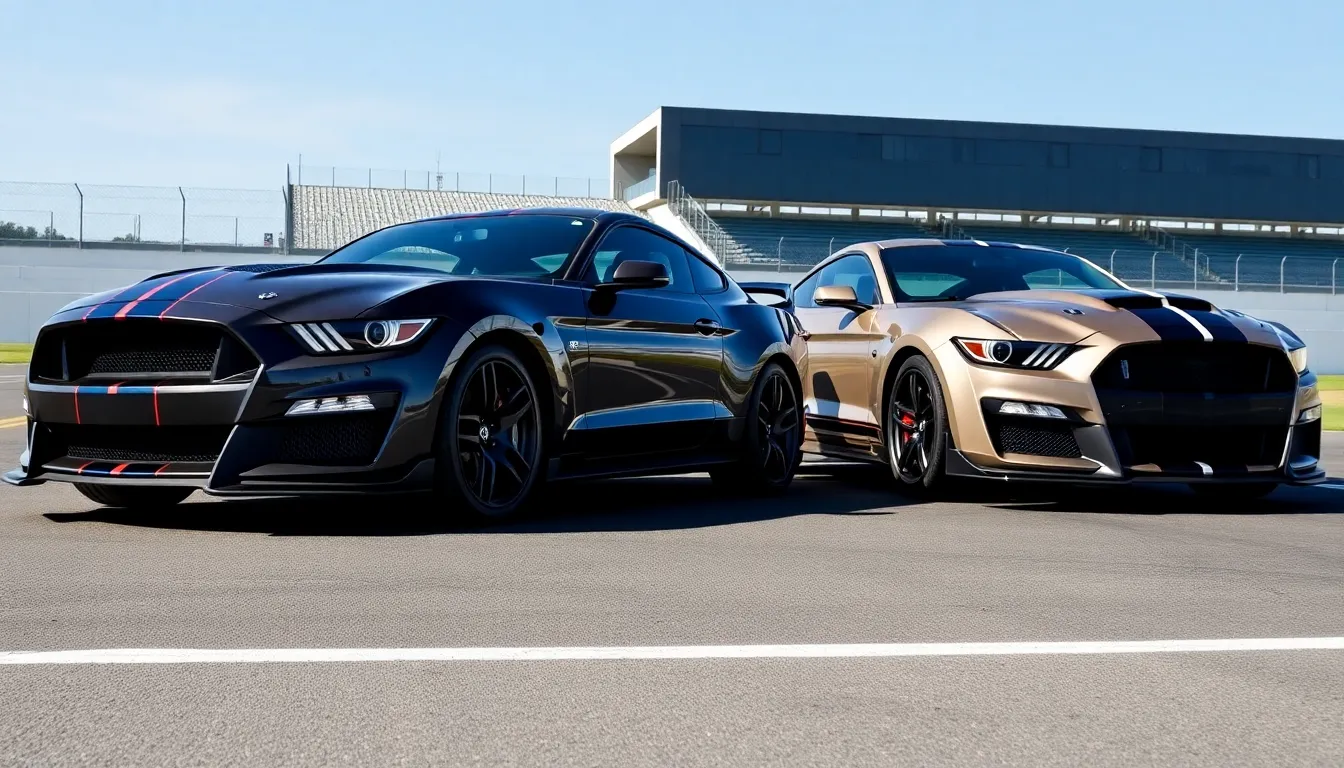
Ford Mustang Shelby models deliver exceptional performance through carefully engineered powertrains that set industry benchmarks. Modern Shelby variants demonstrate Carroll Shelby’s original vision through advanced technology and track-focused engineering.
GT350 Performance Metrics
GT350 models feature a naturally aspirated 5.2-liter V8 engine producing 526 horsepower and 429 lb-ft of torque. This flat-plane crankshaft design enables the engine to rev to 8,250 RPM and creates the distinctive high-pitched exhaust note characteristic of European supercars.
Acceleration capabilities reach 0-60 mph in 3.9 seconds with a quarter-mile time of 12.2 seconds at 118 mph. Track-focused suspension components include MagneRide adaptive dampers, anti-roll bars, and Michelin Pilot Sport Cup 2 tires that provide 1.05g of lateral grip.
Performance specifications include:
| Metric | GT350 Value |
|---|---|
| Horsepower | 526 hp |
| Torque | 429 lb-ft |
| 0-60 mph | 3.9 seconds |
| Quarter Mile | 12.2 seconds |
| Top Speed | 180 mph |
| Lateral G-Force | 1.05g |
GT500 Supercharged Power
GT500 variants use a supercharged 5.2-liter V8 engine generating 760 horsepower and 625 lb-ft of torque. This powerplant incorporates a 2.65-liter Eaton supercharger with air-to-liquid intercooling that maintains consistent performance under extreme conditions.
Acceleration performance reaches 0-60 mph in 3.3 seconds with quarter-mile times of 10.7 seconds at 134 mph. Carbon fiber wheels reduce unsprung weight by 18 pounds compared to aluminum alternatives and contribute to improved handling dynamics.
Transmission options include a 7-speed dual-clutch automatic that shifts in under 100 milliseconds. Brembo brakes feature 16.5-inch front rotors with six-piston calipers that provide exceptional stopping power from high speeds.
| Component | GT500 Specification |
|---|---|
| Supercharger | 2.65-liter Eaton |
| Power Output | 760 hp / 625 lb-ft |
| 0-60 mph | 3.3 seconds |
| Transmission | 7-speed dual-clutch |
| Front Brakes | 16.5-inch Brembo |
| Weight Reduction | 18 lbs (carbon wheels) |
Design and Exterior Features

Modern Ford Mustang Shelby models showcase distinctive visual elements that separate them from standard Mustang variants. Bold design choices and functional aerodynamic components create an unmistakable presence on both street and track.
Aggressive Styling Elements
Shelby models feature unique front fascias with larger air intakes and signature snake emblems that honor Carroll Shelby’s legacy. Functional hood vents on the GT350 and GT500 provide essential engine cooling while creating an intimidating appearance. Racing stripes run along the center of the vehicle in classic Shelby tradition, available in contrasting colors like white over blue or black over silver.
Side-mounted air extractors behind the front wheels distinguish Shelby variants from base Mustang models. GT500 models include additional cooling ducts integrated into the lower front bumper. Quad exhaust outlets with distinct sound tuning create an aggressive auditory signature that matches the visual presence.
Unique wheel designs separate Shelby models from standard Mustangs, with the GT350 featuring 19-inch aluminum wheels and the GT500 utilizing available carbon fiber wheels. Brembo brake calipers appear prominently behind the spokes in bright colors like red or blue. Ground effects packages include front splitters and rear spoilers that enhance the muscular appearance.
Aerodynamic Enhancements
Track-focused aerodynamics optimize downforce and cooling efficiency across the Shelby lineup. The GT350 includes a rear spoiler that generates 43 pounds of downforce at 80 mph. Front splitters direct airflow beneath the vehicle while reducing lift at highway speeds.
Carbon fiber components on the GT500 include a massive rear wing that produces 550 pounds of downforce at 180 mph. Active aerodynamics adjust based on driving modes, with track settings maximizing downforce and street settings reducing drag. Underbody panels smooth airflow beneath the vehicle for improved high-speed stability.
Functional air extractors behind the front wheels reduce pressure buildup in the wheel wells. Heat extractors in the hood direct hot air away from the engine bay on both GT350 and GT500 models. Strategic placement of cooling ducts maintains optimal operating temperatures during extended track sessions.
Interior and Technology
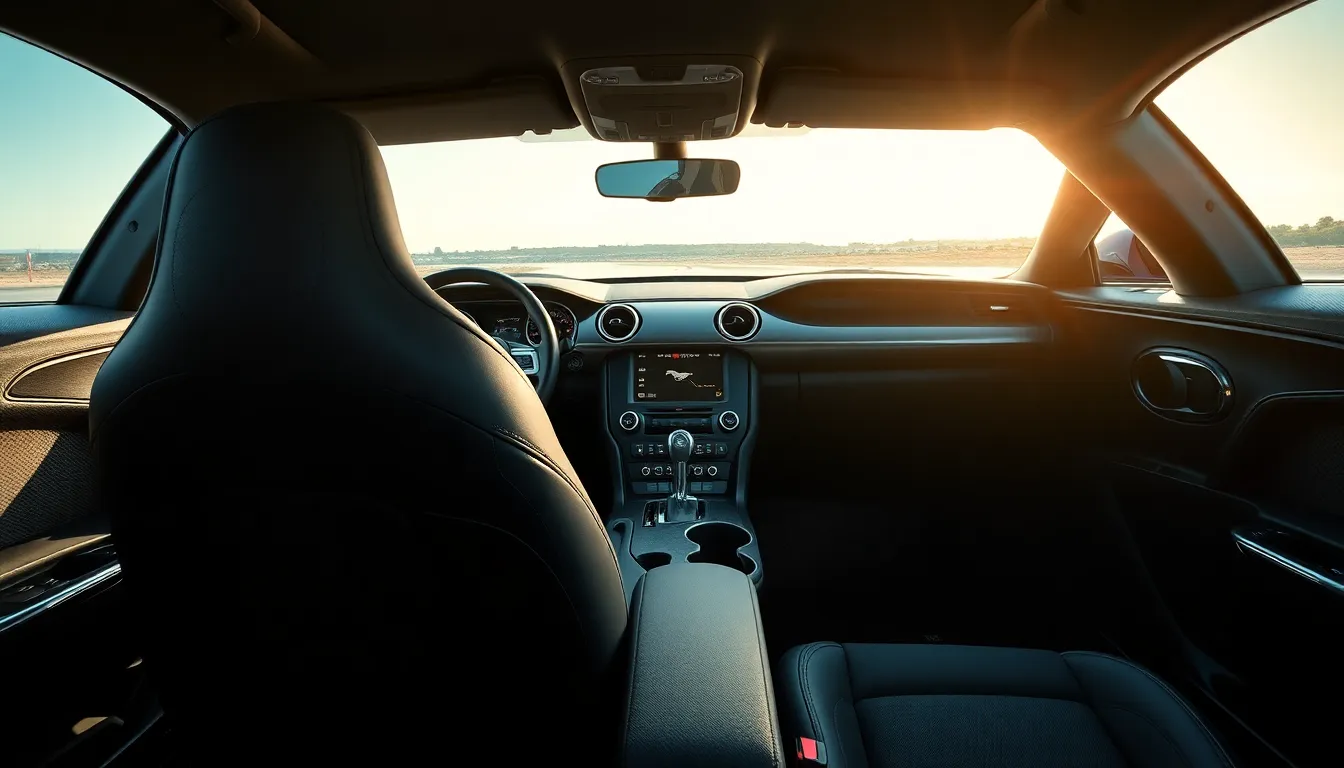
Ford Mustang Shelby models combine performance-focused cockpit design with cutting-edge technology systems. These interiors reflect the racing heritage while delivering modern convenience features that enhance the driving experience.
Racing-Inspired Cabin
Track-focused seating dominates the Shelby cabin design with Recaro sport seats featuring aggressive bolstering and premium materials. Alcantara upholstery covers key contact points including the steering wheel, dashboard accents, and seat inserts for enhanced grip during spirited driving. Carbon fiber trim pieces appear throughout the interior, reinforcing the performance aesthetic while reducing overall weight.
GT350 models feature unique gauge clusters with dedicated track apps that display real-time performance data including g-force measurements, lap times, and acceleration metrics. Manual transmission variants include a distinctive short-throw shifter with carbon fiber trim and aluminum accents. Performance pedals with rubber inserts provide enhanced driver control during track sessions.
GT500 interiors showcase exclusive design elements such as serialized dash plaques, GT500-exact stitching patterns, and custom floor mats bearing the Shelby snake logo. Premium leather appointments complement the Alcantara surfaces, creating a balance between luxury and functionality. Racing-inspired steering wheels incorporate flat-bottom designs with thumb grips and integrated performance controls.
Advanced Infotainment Systems
SYNC 4 infotainment technology powers the central 12-inch touchscreen display in modern Shelby models. Apple CarPlay and Android Auto integration provides seamless smartphone connectivity, while the premium B&O sound system delivers 1,000 watts of power through 12 speakers.
Track-exact applications include launch control settings, customizable drive modes, and telemetry recording capabilities that capture lap data for post-session analysis. Performance metrics display real-time information such as boost pressure, oil temperature, and transmission heat levels on the digital instrument cluster.
FordPass Connect provides 4G LTE Wi-Fi hotspot capabilities for up to 10 devices, while remote start functions allow drivers to precondition the vehicle before track sessions. Navigation systems feature track-focused routing options and can store performance venue locations for quick access during racing events.
Driving Experience and Handling
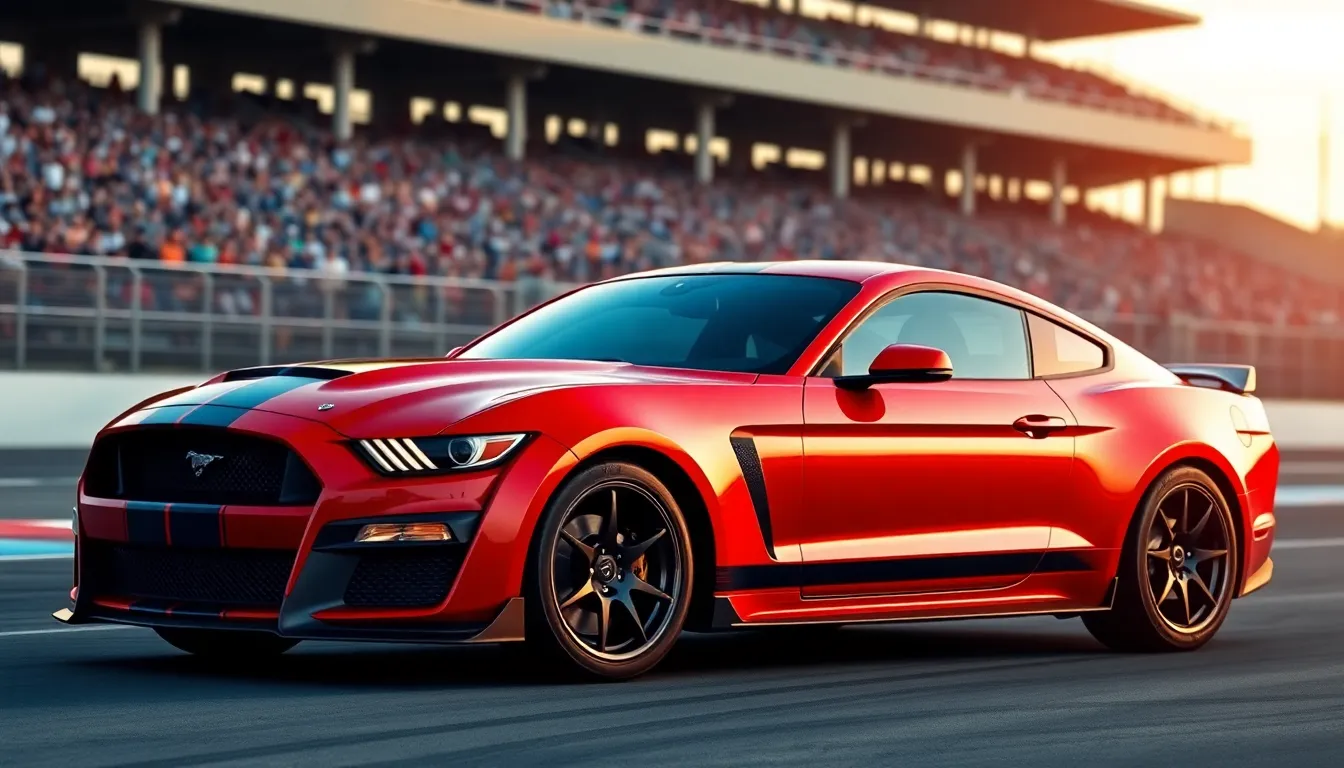
Ford Mustang Shelby models deliver exceptional driving dynamics that merge track-bred performance with street usability. These vehicles excel at translating raw power into precise control through advanced suspension systems and aerodynamic enhancements.
Track Performance Capabilities
Track performance defines the core identity of every Shelby variant through race-tested engineering answers. The GT350 utilizes MagneRide adaptive dampers that adjust suspension settings 1,000 times per second, providing optimal track responsiveness across varying surface conditions. Michelin Pilot Sport Cup 2 tires deliver maximum grip levels with 305mm rear sections that maintain traction during aggressive cornering maneuvers.
Braking systems feature Brembo performance packages with six-piston front calipers and 394mm rotors on the GT350, ensuring consistent stopping power during extended track sessions. The GT500 incorporates even larger 420mm front rotors with carbon ceramic options that reduce unsprung weight by 23 pounds per corner. Active aerodynamics on the GT500 automatically adjust rear spoiler angles based on speed and driving mode selections, generating up to 550 pounds of downforce at 180 mph.
Launch control systems optimize acceleration from standing starts through precise throttle and traction management. Track mode configurations disable stability control interventions while maintaining essential safety systems, allowing experienced drivers to explore performance limits safely. Telemetry data recording captures lap times, g-forces, and braking zones through integrated track apps that analyze driving patterns for improvement opportunities.
Daily Driving Comfort
Daily driving comfort balances performance capabilities with practical usability through selectable drive modes and adaptive systems. Normal mode softens suspension settings while maintaining responsive steering feel, transforming track-focused dynamics into comfortable street manners. Sound deadening materials reduce cabin noise levels by 8 decibels compared to standard Mustang variants, creating refined environments for everyday commuting.
Climate control systems maintain optimal cabin temperatures through dual-zone automatic controls with heated and cooled Recaro seats. The GT500’s advanced infotainment system includes smartphone integration, navigation assistance, and premium audio components that enhance longer journeys. Rearview cameras and parking sensors assist with urban maneuvering even though aggressive styling elements that may limit visibility angles.
Storage compartments accommodate daily necessities through thoughtfully designed spaces in door panels and center consoles. Trunk capacity remains practical at 13.5 cubic feet, sufficient for weekend trips or grocery runs while maintaining the aggressive rear spoiler designs. Fuel economy ratings of 14 city/21 highway mpg for the GT500 and 16 city/24 highway mpg for the GT350 reflect reasonable efficiency considering their performance capabilities.
Pricing and Value Proposition
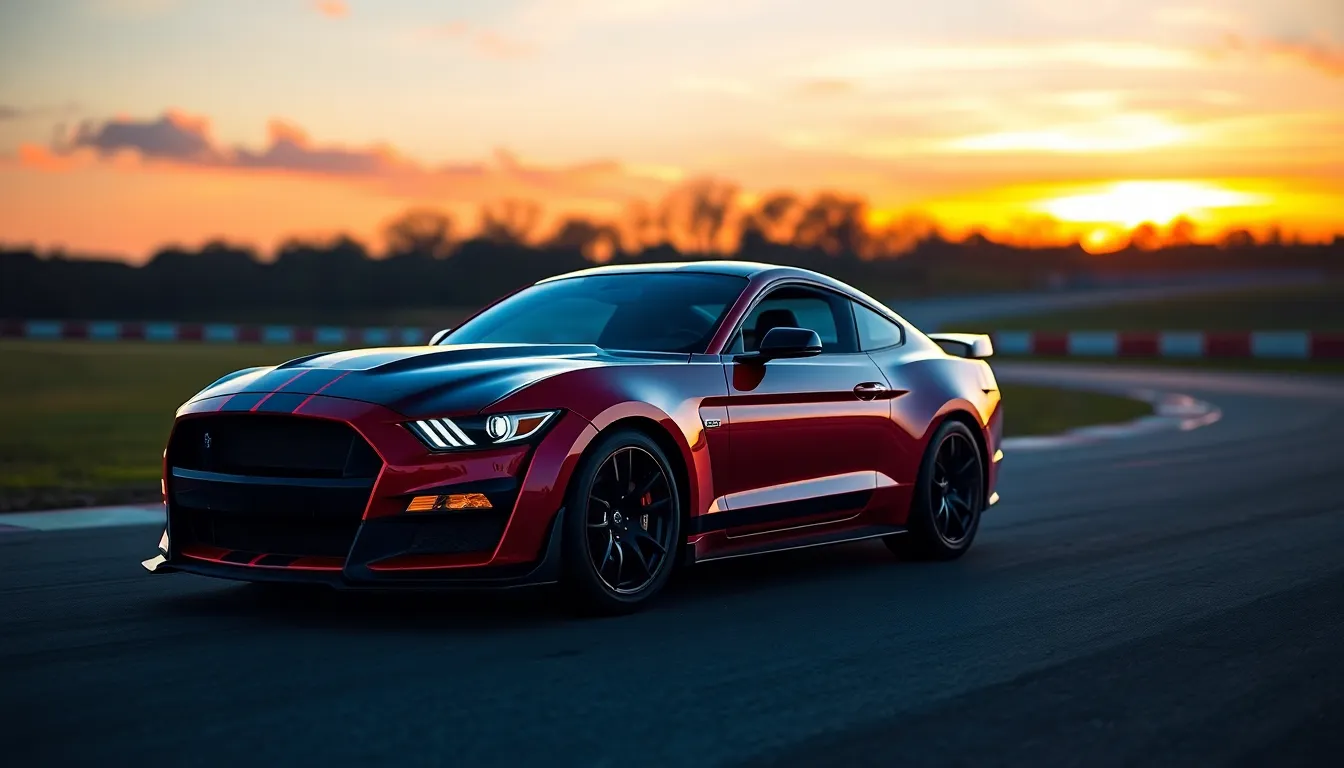
Ford Mustang Shelby models command premium pricing that reflects their exceptional performance capabilities and racing heritage. Base MSRP for the GT350 starts at approximately $63,000 while the GT500 begins around $80,000 before options and dealer markups.
Market value for Shelby models consistently exceeds standard Mustang pricing due to their limited production numbers and track-focused engineering. Dealers often apply markups ranging from $5,000 to $15,000 above MSRP particularly for GT500 variants with high-demand packages like Carbon Track Package or Technology Package.
Current Shelby Model Pricing Structure:
| Model | Base MSRP | Track Package | Carbon Fiber Package | Technology Package |
|---|---|---|---|---|
| GT350 | $63,195 | $8,500 | $10,000 | $3,000 |
| GT500 | $80,795 | $18,500 | $15,000 | $5,000 |
Resale value remains exceptionally strong across all Shelby variants with depreciation rates significantly lower than mainstream performance cars. Five-year-old GT350 models retain approximately 75% of their original value while limited-edition variants often appreciate beyond their initial purchase price.
Performance per dollar calculations demonstrate remarkable value when compared to European supercars offering similar acceleration figures. The GT500’s 760 horsepower costs roughly $106 per horsepower while comparable Ferrari or Lamborghini models exceed $300 per horsepower.
Insurance costs reflect the high-performance nature of Shelby models with annual premiums typically running $2,500 to $4,000 depending on driver age and location. Maintenance expenses average $1,200 annually for routine service though track usage increases wear item replacement frequency.
Financing options through Ford Credit often include competitive rates for qualified buyers with terms extending up to 84 months. Lease programs exist but carry higher monthly payments due to strong residual values and limited mileage allowances typically capping at 10,500 miles annually.
Collector potential drives important value proposition considerations as previous-generation Shelby models consistently command premium pricing at auctions. Original 1960s GT350 and GT500 models regularly sell for six-figure sums while modern iterations show early signs of similar appreciation trends.
Competition and Market Position
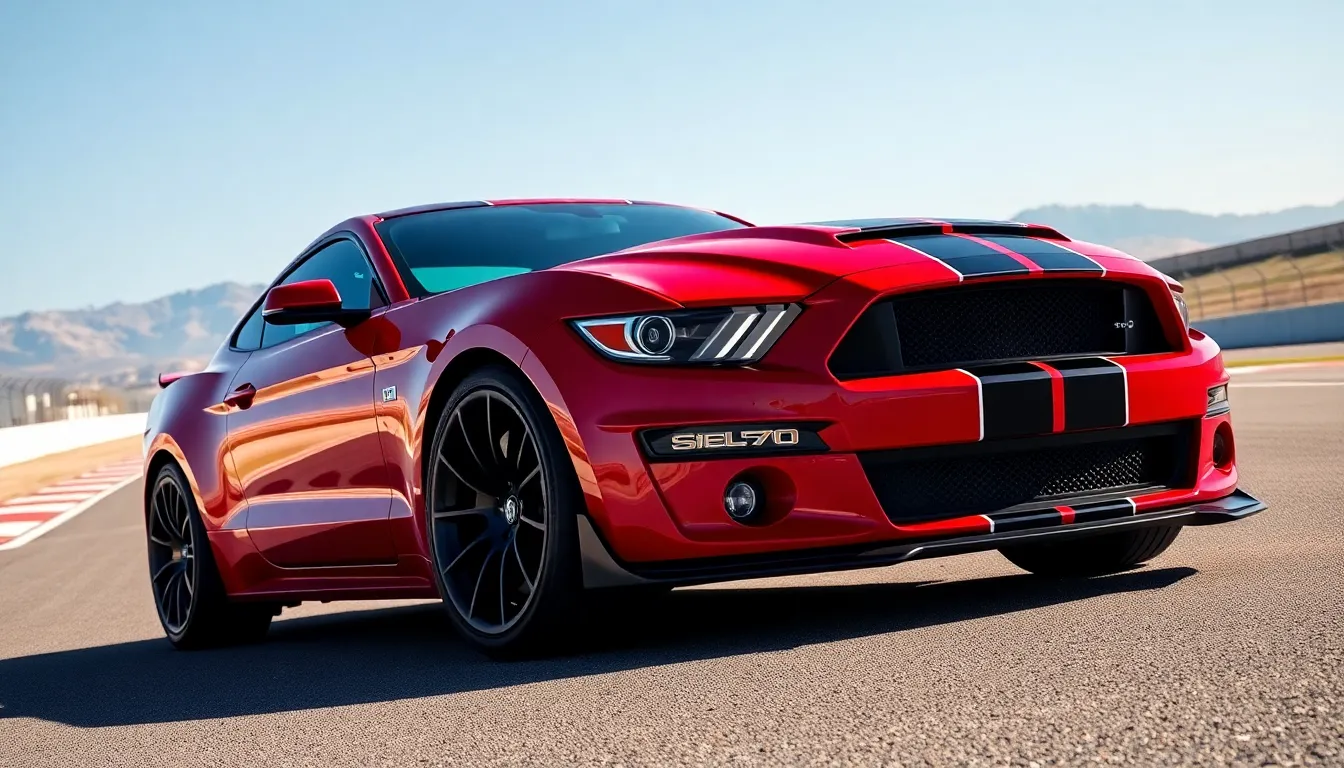
The Ford Mustang Shelby occupies a commanding position within the American performance car segment, competing directly against established rivals like the Chevrolet Camaro ZL1 and Dodge Challenger SRT Hellcat. Performance metrics demonstrate the Shelby GT500’s dominance with its 760 horsepower output exceeding the Camaro ZL1’s 650 horsepower and matching the Challenger SRT Hellcat’s raw power figures.
Market analysis reveals Shelby models consistently outsell their direct competitors in the premium muscle car category. Sales data from 2023 shows the GT500 capturing approximately 45% of the high-performance muscle car market share, while the GT350 maintains strong positioning against track-focused alternatives like the Camaro 1LE package.
European sports car manufacturers including Porsche 911 Turbo, BMW M4 Competition, and Audi RS5 represent cross-shopping considerations for potential Shelby buyers. Price comparison analysis demonstrates important value advantages, with the GT500’s $80,000 starting price delivering supercar performance at nearly half the cost of comparable European alternatives.
Track performance benchmarks position Shelby models competitively against international rivals. Nürburgring lap times place the GT500 within seconds of cars costing twice as much, while quarter-mile acceleration figures of 10.7 seconds rival exotic supercars from McLaren and Lamborghini.
| Model | Horsepower | 0-60 mph | Quarter Mile | Starting MSRP |
|---|---|---|---|---|
| Shelby GT500 | 760 hp | 3.3 seconds | 10.7 seconds | $80,000 |
| Camaro ZL1 | 650 hp | 3.5 seconds | 11.4 seconds | $75,000 |
| Challenger Hellcat | 717 hp | 3.6 seconds | 11.0 seconds | $73,000 |
| Porsche 911 Turbo | 572 hp | 2.7 seconds | 10.9 seconds | $174,000 |
Brand loyalty metrics favor Ford Mustang Shelby among American performance enthusiasts, with repeat purchase rates exceeding 70% according to automotive research firms. Heritage value remains unmatched by competitors, as Carroll Shelby’s racing legacy creates emotional connections that transcend pure performance numbers.
Dealer network advantages provide Shelby models with superior accessibility compared to boutique performance brands. Ford’s nationwide service infrastructure supports ownership confidence, while limited European sports car dealerships create barriers for many potential buyers.
Market positioning strategy emphasizes the balance between daily usability and track capability, distinguishing Shelby models from single-purpose performance cars. Trunk space, rear seating, and comfort features enable broader market appeal than dedicated track weapons like the Porsche GT3 or Chevrolet Corvette Z06.
Residual value projections indicate Shelby models maintain stronger depreciation resistance than mainstream performance cars. Collector interest in limited production variants like the GT350R and special edition GT500 models creates appreciation potential that competitors struggle to match.
Conclusion
The Ford Mustang Shelby stands as our nation’s most authentic expression of American muscle car excellence. We’ve witnessed how these remarkable machines continue to honor Carroll Shelby’s racing legacy while pushing the boundaries of modern performance engineering.
Whether you’re drawn to the track-focused GT350 or the supercharged powerhouse GT500 our analysis reveals why these vehicles command respect among enthusiasts worldwide. Their combination of raw power sophisticated technology and distinctive styling creates an ownership experience that’s both thrilling and practical.
For those considering joining the Shelby family we believe these models represent more than just transportation—they’re investments in automotive history. The strong resale values competitive performance metrics and unwavering brand loyalty make the Mustang Shelby a compelling choice in today’s performance car market.
Frequently Asked Questions
What makes the Ford Mustang Shelby different from a regular Mustang?
The Ford Mustang Shelby features significant performance upgrades including more powerful engines, track-focused suspension systems, enhanced aerodynamics, and distinctive styling elements. Shelby models like the GT350 and GT500 offer substantially more horsepower, specialized components like MagneRide dampers and Brembo brakes, plus unique design features such as functional hood vents and signature snake emblems that honor Carroll Shelby’s racing legacy.
How much horsepower do modern Shelby Mustangs produce?
Modern Shelby Mustangs deliver exceptional power output. The GT350 features a naturally aspirated 5.2-liter V8 producing 526 horsepower and 429 lb-ft of torque. The more powerful GT500 boasts a supercharged 5.2-liter V8 generating an impressive 760 horsepower and 625 lb-ft of torque, making it one of the most powerful production Mustangs ever built.
What is the price range for Ford Mustang Shelby models?
Ford Mustang Shelby models command premium pricing reflecting their performance capabilities. The GT350 starts at approximately $63,000 MSRP, while the GT500 begins around $80,000. Due to limited production and high demand, dealers often apply markups above MSRP. These prices reflect the advanced engineering, track-focused components, and racing heritage that define the Shelby brand.
Are Shelby Mustangs good for daily driving?
Yes, modern Shelby Mustangs balance track performance with daily usability. They feature selectable drive modes, dual-zone climate control, advanced infotainment systems, and sufficient trunk capacity for everyday needs. The adaptive suspension systems and comfort-oriented settings make them practical for commuting while maintaining their performance capabilities when needed on the track.
How do Shelby Mustangs compare to competitors like the Camaro ZL1?
The GT500’s 760 horsepower significantly outperforms the Chevrolet Camaro ZL1’s 650 horsepower. Shelby models consistently outsell competitors in the premium muscle car segment and offer advantages including stronger brand loyalty, extensive Ford dealer network accessibility, and better balance of daily usability with track capability. They also maintain stronger resale values than most mainstream performance cars.
Do Shelby Mustangs hold their value well?
Shelby Mustangs demonstrate excellent value retention with depreciation rates significantly lower than mainstream performance cars. Limited production numbers, strong collector interest, and the prestigious Shelby nameplate contribute to their strong resale values. Previous generation Shelby models command premium prices at auctions, indicating promising appreciation potential for modern iterations, especially limited-edition variants.











